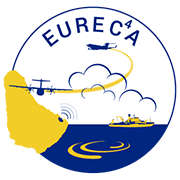27 Jan
Each pre-EUREC4A season is an opportunity to stay tuned on NASA WorldView and watch every day the beauty and diversity of cloud patterns over the Atlantic trades (Fig 1). From isolated clouds to cloud clusters, which can organize in bands, arcs or more regular patterns, clouds in the trades exhibit a large diversity of organizations over a large range of scales.
How diverse? Although at first sight there might seem to be an infinite number of organizations, after many hours spent looking at MODIS imagery near Barbados (something that some of us enjoyed doing in the past during a EUREC4A workshop organized at the International Space Science Institute in Bern), your brain starts recognizing several types of recurrent patterns, which can start as a basis for a classification of shallow cloud patterns. Four of them, that were given nicknames such as "Sugar", "Gravel", "Fish" and "Flowers"), are illustrated below (Fig 2).
Future posts will tell you more about this classification, how it became a new social and fun activity at MPI and LMD over the last months, and how it will eventually be used to train machine learning algorithms. Just be patient.
The beauty of these cloud patterns does not only excite our imagination. It also challenges our understanding of cloud-circulation couplings in the tropical atmosphere: what are the physical mechanisms controlling these mesoscale organizations? Are they related to local atmospheric processes associated with interactions between convection and moisture, or between radiation and circulation? (more about the latter in a future post by Ann-Kristin Naumann). How much are they locally vs remotely controlled? (Franziska Aemisegger might tell us more about it thanks to her isotopic analyses). How much are they influenced by heterogeneities at the surface, such as mesoscale and submesoscale ocean eddies, filaments and fronts discussed by Jim McWilliams a few posts ago? Much should be learned about this next year from EUREC4A and EURECA-OA/ATOMIC observations.
Beyond the origin of cloud organizations, other questions arise: how much do these patterns matter for climate and climate sensitivity? Could they play a role in cloud feedbacks? For this to happen, the different cloud organizations should depend on large-scale environmental conditions and impact the Earth’s radiation budget in a contrasted way.
We have started to investigate these issues using long time series of satellite observations. Geostationnary satellite observations have allowed us to detect the different types of organization discussed above and to study their variability at daily and interannual time scales. It appears that these different organizations do exhibit a dependence on large-scale environmental conditions, especially surface temperature and wind, and they are associated with contrasted cloud and radiative properties. This suggests that the mesoscale organization of shallow clouds might actually matter for low-cloud feedbacks. An additional challenge for climate models? A raw extrapolation of observational results to climate change suggests that as the climate warms, the relative prominence of the different patterns might change, and that in the future flower patterns might become less frequent relative to other patterns. Wouldn't it be sad if our children and grand-children could not enjoy satellite images of the Atlantic ocean as beautiful as those we enjoy now?
Before cloud flowers may disappear, we will have a lot to learn about them. Hauke Schultz will tell you more about it tomorrow. And EUREC4A will tell us even more.
